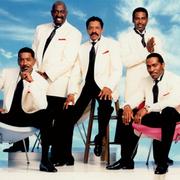The Temptations
"MY GIRL"此曲于1965年3月6日进入榜首,为期一周。作者为William “Smokey” Robinson和Ronald White,由Gordy唱片公司以片号7038出版发行。在录制了几首由Motown唱片公司创始人Berry Gordy Jr.制作的歌曲后,诱惑演唱组又以The Miracles演唱组的领唱William “Smokey” Robinson为首进行了重组。由Robinson写的这支歌曲,促使Motown旗下的男声组合,首次进入排行榜首。它和Mary Wells演唱的《My Guy-我的男人》遥相呼应,是另一首和Gordy这个名字有关的Motown唱片公司发行的榜首曲。诱惑演唱组实际上是The Primes和The Distants这两个组合的合并重组。这两个组合的经纪人都是Milton Jenkins。当这两个组合呈失败状态时,合并成为一个称做The Elgins的五人组合。Eddie Kendrics和Paul Williams两人都住在阿拉巴马州的伯明翰,且相距不远。他们纠集了友人Cal Osborne和Willy Waller组成了The Cavaliers演唱组,然后迁到俄亥俄州的克里夫兰。Jenkins在那里发现了他们,建议他们到底特律去谋求发展。Eddie,Paul,Cal三人果然去了,组建成The Primes演唱组。不久,Jenkins觉得他们应当有个相应的女声组合,于是便有了The Primettes(The Supremes的前身)。Otis Miles原名Otis Williams,是在德州Taxarkama的一个农场了长大的。1950年迁到了底特律。七年后,他与友人Elbridge Bryant在街角以二重唱形式卖唱。1959年,他们和在西北中学就读的友人Melvin Franklin(原名David English)及Williams的表兄弟Richard Street还有Albert Harrell共同建立组合,取名The Elegants,后来又改成The Questions。最后,他们以The Distants的名义和Northern唱片公司签定了一纸合同。他们的首支单曲是由Otis Williams执笔的《Come On》,是由Street主唱的。在录制了几张没能成功的唱片后,Street和Harrell撤出了演唱组(Street另组了一支Motown旗下的演唱组The Monitors,1971年时又回到诱惑小组),这时Jenkins又引进了Kendricks和Paul Williams组成了The Elgins。The Elgins和Berry Cordy新开的Miracle唱片公司签了约。但在他们的首张唱片《Oh Mother Of Mine》于1961年8月发行前,Otis Williams和Motown的雇员Bill Mitchell一起,为组合起了个新名字-The Temptations。他们为Miracle公司又出了一张唱片后,便转到新成立的Gordy唱片公司去了。Robinson和The Temptation的联系是由那曲《I Want A Love I Can See》开始的。这张唱片在销售线上挣扎之时,Bryant感觉The Temptations成不了气候,便离了队。取代他的是由密西西比州Meridian来的Motown签约独唱歌手David Ruffin。这个新阵容录制了Robinson作曲的,由Kendricks主唱的《The Way You Do The Things You Do》,成为他们的第一支上榜曲。 Kendricks又唱了两支单曲(《I’ll Be In Trouble》及《Girl(Why You Wanna Make Me Blue)》)后,Robinson转请Ruffin作为《My Girl》的主唱。Robinson在录音棚中做《My Girl》的韵律录制时,The Miracles和The Temptations正在哈莱姆区的阿波罗剧院同台演出。Robinson本来想以他自己的组合来录制这支歌曲的。可是The Temptations听到了以后,恳求Robinson让他们录制,最后Robinson还是答应了,并和这个组合一起在顶楼的化装室进行了一个星期的排练。他们1964年12月21日回到底特律录制了这首《My Girl》。单曲唱片1965年1月16日进入排行榜76位,3月6日达榜首。Robinson为The Temptations后来又连写带制作了四支上榜曲(《It’s Growing》,《Since I Lost My Baby》,《My Baby》,《Get Ready》)。然后Norman Whitfield接过了缰绳,在之后的六年中,为The Temptations又写出了三支榜首曲。 by Jason AnkenyThanks to their fine-tuned choreography — and even finer harmonies — the Temptations became the definitive male vocal group of the 1960s; one of Motowns most elastic acts, they tackled both lush pop and politically charged funk with equal flair, and weathered a steady stream of changes in personnel and consumer tastes with rare dignity and grace. The Temptations initial five-man lineup formed in Detroit in 1961 as a merger of two local vocal groups, the Primes and the Distants. Baritone Otis Williams, Elbridge (aka El, or Al) Bryant, and bass vocalist Melvin Franklin were longtime veterans of the Detroit music scene when they joined together in the Distants, who in 1959 recorded the single Come On for the local Northern label. Around the same time, the Primes, a trio comprised of tenor Eddie Kendricks, Paul Williams (no relation to Otis), and Kell Osborne, relocated to the Motor City from their native Alabama; they quickly found success locally, and their manager even put together a girl group counterpart dubbed the Primettes. (Later, three of the Primettes — Diana Ross, Mary Wilson and Florence Ballard — formed the Supremes).In 1961, the Primes disbanded, but not before Otis Williams saw them perform live, where he was impressed both by Kendricks vocal prowess and Paul Williams choreography skills. Soon, Otis Williams, Paul Williams, Bryant, Franklin, and Kendricks joined together as the Elgins; after a name change to the Temptations, they signed to the Motown subsidiary Miracle, where they released a handful of singles over the ensuing months. Only one, the 1962 effort Dream Come True, achieved any commercial success, however, and in 1963, Bryant either resigned or was fired after physically attacking Paul Williams. The Tempts fortunes changed dramatically in 1964 when they recruited tenor David Ruffin to replace Bryant; after entering the studio with writer/producer Smokey Robinson, they emerged with the pop smash The Way You Do the Things You Do, the first in a series of 37 career Top Ten hits. With Robinson again at the helm, they returned in 1965 with their signature song, My Girl, a number one pop and R&B hit; other Top 20 hits that year included Its Growing, Since I Lost My Baby, Dont Look Back, and My Baby.In 1966, the Tempts recorded another Robinson hit, Get Ready, before forgoing his smooth popcraft for the harder-edged soul of producers Norman Whitfield and Brian Holland. After spotlighting Kendricks on the smash Aint Too Proud to Beg, the group allowed Ruffin to take control over a string of hits including Beautys Only Skin Deep and (I Know) Im Losing You. Beginning around 1967, Whitfield assumed full production control, and their records became ever rougher and more muscular, as typified by the 1968 success I Wish It Would Rain. After Ruffin failed to appear at a 1968 live performance, the other four Tempts fired him; he was replaced by ex-Contour Dennis Edwards, whose less polished voice adapted perfectly to the psychedelic-influenced soul period the group entered following the success of the single Cloud Nine. As the times changed, so did the group, and as the 1960s drew to a close, the Temptations music became overtly political; in the wake of Cloud Nine — its title a thinly veiled drug allegory — came records like Run Away Child, Running Wild, Psychedelic Shack, and Ball of Confusion (Thats What the World Is Today).After the chart-topping success of the gossamer ballad Just My Imagination (Running Away With Me) in 1971, Kendricks exited for a solo career. Soon, Paul Williams left the group as well; long plagued by alcoholism and other personal demons, he was eventually discovered dead from a self-inflected gunshot on August 17, 1973, at the age of 34. In their stead the remaining trio recruited tenors Damon Harris and Richard Street; after the 1971 hit Superstar (Remember How You Got Where You Are), they returned in 1972 with the brilliant number one single Papa Was a Rolling Stone. While the Tempts hit the charts regularly throughout 1973 with Masterpiece, Let Your Hair Down, and The Plastic Man, their success as a pop act gradually dwindled as the 1970s wore on. After Harris exited in 1975 (replaced by tenor Glenn Leonard), the group cut 1976s The Temptations Do the Temptations, their final album for Motown. With Louis Price taking over for Edwards, they signed to Atlantic, and attempted to reach the disco market with the LPs Bare Back and Hear to Tempt You.After Edwards returned to the fold (resulting in Prices hasty exit), the Temptations re-entered the Motown stable, and scored a 1980 hit with Power. In 1982, Ruffin and Kendricks returned for Reunion, which also included all five of the current Tempts; a tour followed, but problems with Motown, as well as personal differences, cut Ruffins and Kendricks tenures short. In the years that followed, the Temptations continued touring and recording, although by the 1990s they were essentially an oldies act; only Otis Williams, who published his autobiography in 1988, remained from the original lineup. The intervening years were marked by tragedy: after touring in the late 80s with Kendricks and Edwards as a member of the Tribute to the Temptations package tour, Ruffin died on June 1, 1991, after overdosing on cocaine; he was 50 years old. On October 5, 1992, Kendricks died at the age of 52 of lung cancer, and on February 23, 1995, 52-year-old Franklin passed away after suffering a brain seizure. In 1998, the Temptations returned with Phoenix Rising; that same year, their story was also the subject of a well-received NBC television miniseries. Ear-Resistable followed in the spring of 2000.


 My girl - The Temptations
My girl - The Temptations




























![[STATION] aespa《Dreams Come True》MV Teaser - aespa (에스파)](https://img2.kuwo.cn/wmvpic/324/79/54/2120387380.jpg?imageView2/1/w/195/h/130/format/jpg/q/60)





